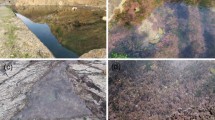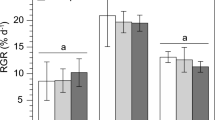Abstract
The seasonal variation of phytoplankton photosynthesis was measured with 14C-method in a warmed ice-free pond in central Finland. Simultaneously with in situ measurements the photosynthesis was also measured in an incubator with different water temperatures and constant light (ca. 16 W m−2). The total annual photosynthesis was 57.2 C m−2 a−1. The portion of the winter and spring production of the annual photosynthesis was 18.4%, that of the autumn production ws 17.4%. Thus 64.3% of the total annual phytoplankton photosynthesis occurred in the three summer months. The range of the daily integrated photosynthesis per unit area was 1.9—563 mg C m−2d−1. The photosynthetic rate per unit chlorophyll a varied in situ from 0.94 to 33.1 mg C (mg chl. a)−1 d−1. The highest value was measured in the beginning of July and the lowest in mid-January. The photosynthetic rate increased in situ exponentially with increasing water temperature. In the incubator the highest photosynthetic rate values were also found in July and August (at+20 °C) when the phytoplankton population was increasing and the minimum values occurred after every diatom maximum both in spring and autumn. Light was a limiting factor for photosynthesis from September to Mid-January, low water temperature was a limiting factor from late January through May. The efficiency of the photosynthesis varied between 0.1 and 0.7% of P.A.R. According to the incubator experiments the Q10 values for the photosynthesis were 2.45 and 2.44 for the winter population between 1 and 10° C and for the summer population between 5 and 15° C, respectively, but the Q10 values decrease at the higher temperatures. The main effect of the warm effluents on the yearly photosynthesis was the increase of production in spring months due to the lack of ice cover. However, the increase of total annual phytoplankton photosynthesis was only ca. 10–15%, because the water temperature was during the spring months below 10° C.
Similar content being viewed by others
References
Aruga, Y., 1965. Ecological studies of photosynthesis and matter production of phytoplankton. II. Photosynthesis of algae in relation to light intensity and temperature. Bot. Mag. Tokyo 78: 360–365.
Dubinsky, Z. & T. Berman, 1976. Light utilization efficiencies of phytoplankton in Lake Kinneret (Sea of Galilee). Limnol. Oceanogr. 21: 226–230.
Eloranta, P., 1976. Phytoplankton and primary production in situ in the lakes Jyväsjärvi and North Päijänne in summer 1974. Biol. Res. Rep. Univ. Juväskylä 2: 51–66.
Eloranta, P., 1980a. Winter phytoplankton in a pond warmed by a thermal power station. Ann. Bot. Fennici 17: 264–275.
Eloranta, P., 1980b. Annual succession of the phytoplankton in one heated pond in central Finland. Acta Hydrobiol. 22: 421–438.
Eloranta, P., 1981a. Yearly succession of the phytoplankton in an ice-free pond in central Finland. Schweiz. Z. Hydrol. 43: 20–33.
Eloranta, P., 1981b. Winter plankton in one eutrophic, ice-free pond in central Finland. Verh. int. Ver. Limnol. 21: 1187–1193.
Eloranta, P., 1982a. Seasonal succession of phytoplankton in an ice-free pond warmed by a thermal power plant. Hydrobiologia 86: 87–92.
Eloranta, P. V., 1982b. Zooplankton in the Vasikkalampi pond, a warm water effluent recipient in Central Finland. J. Plankton Res. 4: 813–837.
Eloranta, P. V., 1982c. Periphyton growth and diatom community structure in a cooling water pond. Hydrobiologia 96: 253–265.
Eloranta, P. V., 1983. Physical and chemical properties of pond waters receiving warm-water effluent from a thermal power plant. Water Res. 17: 133–140.
Eppley, R. W. & J. H. Sharp, 1975. Photosynthetic measurements in the central North Pacific: The dark loss of carbon in 24-h incubations. Limnol. Oceanogr. 20: 981–987.
Gächter, R., 1972. Die Bestimmung der Tagesraten der planktischen Primärproduktion-Modelle und in situ-Messungen. Schweiz. Z. Hydrol. 34: 211–244.
Ganf, G. G., 1975. Photosynthetic production and irradiance-photosynthesis relationships of the phytoplankton from shallow equatorial lake (Lake George, Uganda). Oecologia (Berl.) 18: 165–183.
Golterman, H. L. & R. S. Clymo (eds.), 1971. Methods for chemical analysis in fresh waters. Oxford, 180 pp.
Hallegraeff, G. M., 1976. Pigment diversity, biomass and species diversity of phytoplankton of three Dutch lakes. Diss., Instit. Anim. Physiol., Univ. Amsterdam, 177 pp.
Harris, G. P. & B. B. Piccinin, 1977. Photosynthesis by natural phytoplankton populations. Arch. Hydrobiol. 80: 405–457.
Hitchcock, G. L. & T. J. Smayda, 1977. The importance of light in the initiation of the 1972–1973 winter-spring diatom bloom in Narragansett Bay. Limnol. Oceanogr. 22: 126–131.
Ilmavirta, K. & A.-L. Kotimaa, 1974. Spatial and seasonal variations in phytoplanktonic primary production and biomass in the oligotrophic lake Pääjärvi, southern Finland. Ann. Bot. Fennici 11: 112–120.
Ilmavirta, V., 1974. Diel periodicity in the phytoplankton community of the oligotrophic lake Pääjärvi, southern Finland. I. Phytoplanktonic primary production and related factors. Ann. Bot. Fennici 11: 126–177.
Ilmavirta, V., 1982. Dynamics of phytoplankton in Finnish lakes. Hydrobiologia 86: 11–20.
Ilmavirta, V., K. Ilmavirta & A.-L. Kotimaa, 1974. Phytoplanktonic primary production during the summer stagnation in the eutrophicated lake Lovojärvi and Ormajärvi, southern Finland. Ann. Bot. Fennici 11: 121–132.
Jewson, D. H., 1976. The interaction of components controlling net phytoplankton photosynthesis in a well-mixed lake (Lough Neagh, Northern Ireland). Freshwat. Biol. 6: 551–576.
Jewson, D. H. & J. A. Taylor, 1978. The influence of turbidity on net phytoplankton photosynthesis in some Irish lakes. Freshwat. Biol. 8: 573–584.
Jonasson, P. M. & Adalsteinsson, 1979. Phytoplankton production in shallow eutrophic Lake Mývatn, Iceland. Oikos 32: 113–138.
Talling, J. F., 1957. Photosynthetic characteristics of some freshwater plankton diatoms in relation to underwater radiation. New Phytol. 56: 29–50.
Talling, J. F., 1971. The underwater light climate as a controlling factor in the production ecology of freshwater phytoplankton. Mitt. Internat. Verein. Limnol. 19: 214–243.
Tilzer, M. M., C. R. Goldman & E. de Amezaga, 1975. The efficiency of photosynthetic light energy utilization by lake phytoplankton. Verh. Internat. Verein. Limnol. 19: 800–807.
Vollenweider, R. A., 1969. Primary production in aquatic environments. IPB Handbook 12. Blackwell Scientific Publications, Oxford, 213 pp.
Wetzel, R. G., 1975. Limnology. Saunders, Philadelphia, 743 pp.
Author information
Authors and Affiliations
Rights and permissions
About this article
Cite this article
Eloranta, P.V., Salminen, R. Phytoplankton primary production in a eutrophic cooling water pond. Hydrobiologia 118, 267–274 (1984). https://doi.org/10.1007/BF00046624
Received:
Revised:
Accepted:
Issue Date:
DOI: https://doi.org/10.1007/BF00046624




